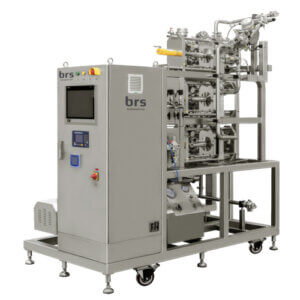Introduction to Membrane Ultrafiltration
Membrane filtration is a pressure separation process that uses membranes to separate components in a liquid solution or suspension based on their size and differences in charge. Ultrafiltration is a type of membrane filtration in which hydrostatic pressure forces liquid against a semi-permeable membrane. Solvent and low molecular weight solutes pass through the membrane and are called permeate, while suspended solids and high molecular weight solutes are retained (retentate).
Ultrafiltration is used in scientific research, in biotechnological, biopharmaceutical industries for the separation and concentration of macromolecular solutions (1-1000 kDa). Depending on the cutoff range of the membrane, macromolecules can be purified, separated or concentrated in any fraction. The ultrafiltration process separates proteins from small peptides and/or salts. This method finds wide application in the processes of separation and concentration of monoclonal antibodies, vaccines, blood plasma, and therapeutic proteins.
The main types of filtration in biotechnology
There are two main types of filtration: normal flow/dead end filtration (NFF) and tangential flow filtration (TFF).
In normal flow or “dead end” filtration, the fluid is directed directly to the membrane under applied pressure. Large particles accumulate on the surface of the membrane or deep in the filter medium, while smaller molecules pass to the downstream side.
In tangential filtration, the liquid is pumped tangentially along the membrane surface. The applied pressure serves to force some of the liquid through the membrane to the filtrate side. In TFF, the retained components do not accumulate on the membrane surface, instead they are carried away by the tangential flow.
The main applications of TFF are concentration, diafiltration (desalting and buffer exchange) and fractionation of large biomolecules from small ones. Cross-flow filtration units are also used to clarify and remove cells or cell debris from a cell culture or fermentation medium.
Advantages of the tangential filtration method
TFF prevents the formation of “filter cake”, providing a high rate of liquid removal.
Technological raw materials remain in the form of a mobile suspension, which can be used for further recycling.
The solids content of the product slurry can be adjusted over a wide range.
It is possible to fractionate particles by size during TFF.
Application of tangential filtration in biotechnology
Protein Purification
Make-up cleaning
Diafiltration (DF) for buffer exchange
Desalting and concentrating biomolecules such as proteins and DNA or RNA
Cell Suspension Concentration
Clarification and desalting of the whole cell lysate
Sample preparation for chromatography
How to optimize tangential flow filtration?
The filtration process can be optimized by controlling key parameters such as cross flow rate, transmembrane pressure and filter membrane type. The systems are cleaned using the CIP (cleaning in place) method. The use of disposable hollow fiber cartridges is also a popular solution as it eliminates the need for cleaning protocols and cleaning validation.
What is the difference between ultrafiltration and diafiltration?
Commonly used in buffer exchange, diafiltration provides improved storage stability of the drug, and ultrafiltration membranes help concentrate the sample to the final drug concentration.
What are the main features of BRS tangential filtration systems?
BRS manufactures filtration systems in accordance with the technical requirements of the customer. Modular design and a wide range of options allow you to choose the optimal solution to the technological task of the client.
- Modular design allows you to create unique system configurations in accordance with customer requirements
- Full automation of the system allows you to speed up the process of conducting preclinical and clinical studies in accordance with GMP requirements
- Optimal design of all components minimizes dead volume, increases system performance
- Highly sensitive online pressure, pH, UV, electrical conductivity detectors of your choice
- Controller with an intuitive interface. Software according to FDA 21 CFR Part 11
What filtration elements are used in BRS systems?
To select a filtration element, you need a technical task or a name from the catalog of leading manufacturers for the selection of an analogue. We offer polymer membrane elements, hollow fiber filters. The characteristics of some polymeric materials used in filter elements are given below:
- Polypropylene (PP). Physically and chemically stable material, resistant to pressure. Used in depth filtration.
- Polyethersulfone (PES). Resistant to a wide pH range, organic solvent, temperatures up to 150C. It is used for sterilization, filtration from mycoplasmas.
- Polyvinylidene fluoride (PVDF). Resistance to pH range 2-10, resistance to organic solvents, low protein binding. Used for filtering culture media, vaccines, biological products.
- Polytetrafluoroethylene (PTFE). Hydrophobic material resistant to corrosion and organic solvents. Used in biopharmaceutical processes, air filtration.
How to get a quote on an ultrafiltration system by BRS?
BRS manufactures ultrafiltration systems in accordance with customer requirements, the process of preparing a commercial proposal may include the following steps:
- Obtaining a technical specification from a customer for a tangential filtration system (laboratory, pilot, industrial) or a commercial offer for a system from well-known manufacturers to select an analogue
- Additional coordination of options (pH sensors, electrical conductivity, etc.) and additional equipment (circulation cooler) if necessary
- Selection of filtration elements / filters, including analogues of leading world manufacturers, if necessary
- Preparation of a diagram, descriptions of the modules of the filtration system (filtration module, recirculation, etc.) indicating materials and manufacturers of elements
- Calculation of the final cost of the approved system, taking into account delivery, a set of documentation, commissioning and other necessary work
- Development and provision of a 3D drawing of the filtration system after placing an order











